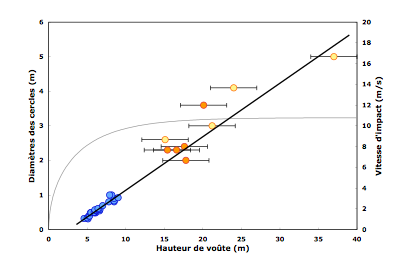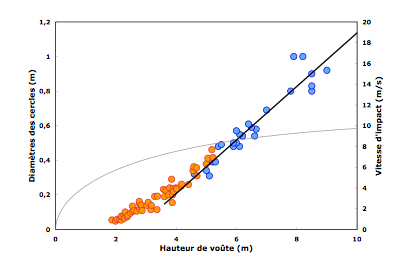The Cave Rings Mystery
Le Mystère des Cercles Noirs
Some very special speleothems
The perfect circles drawn on the floor of some caves are mysterious speleothems. Usually rare, they can be abundant in some places. We had the opportunity to meet such forms several times during our expeditions in Laos. The first time in 2004, in Tham Mo (also named Tham Pha Leusi, Ban Vang Hin, upper Nam Pakan valley), then in 2007, in Tham En (Ban Nong Ping, Xe Bang Fai valley), and finally in 2008 in the Cave of the Clouds (Xe Bang Fai cave).


Photo 1 and 1a - Black cave ring in Tham En, Laos ( R. Huttler, 2008)
However, these very special speleothems are not new. F. Brouquisse has reported similar observations in Tham Boumlou (lower Nam Pakan river cave - Gallery of the Stone Sentinels) in 2002. In North Laos, near Van Vieng, Renouard et al. (2001) have observed hundreds of these rings in Tham Lom. They are not exclusive to Laos and some observations, made in Brazil and Italy, have already been published (Montanaro, 1992; Auler, 1993; Hill and Forti, 1998 ...). The phenomenon seemed interesting and unusual enough to trigger, in 2008, a thorough study of some of its aspects.

The ground nature does not matter and the rings can be present on boulders or on soils of calcite or clay. In the latter case, the rings have been observed in areas flooded and covered with clay during the rainy season. This indicates that the rings can be formed within a few months, when the pools are dry, between two rain seasons. A sampling across the clay deposits would bring interesting informations.
Figure 1 - Relationship between passage height and ring diameter in Tham En. The color of the dots corresponds to three series of measurements in different areas of the cave. The impact velocity (thin line), calculated for a 5 mm diameter water droplet is also plotted on the graph.

Photo 2 - Random and asymetric trajectories of splash droplets after ground impact
Finally, several observations show that the rings can be formed even when the impact point on the ground takes place in a crevice preventing lateral projections. This is clearly demonstrated with the ring deposited on a broken block, found in the Cave of the Clouds: seen from above, it has the appearance of a "normal" ring, albeit discontinuous, while the drop impact point is about twenty centimeters below, between the blocks. Seen from the side, the circle is developed on several levels.


Photo 3 and 3 bis - The broken ring in the Cave of the Clouds, top and side view.
The impact point is in between the broken rock . The shuunto is lying on the upper piece.

Figure 2 - Correlation between ring diameter and ceiling height in Tham En. The impact velocity, calculated for a 5 mm drop, is also reported.

A possible way of elucidation of the phenomenon was initiated through discussions with several physicists, specialists in fluid dynamics. From these discussions it is clear that the hypothesis of a drop fragmentation is difficult to support. The behavior of drops has indeed been widely studied because of its importance in fields as distant as the optimization of the operation of inkjet printers or of weather forecasting. It is known that during the formation of a drop by detachment at the end of a capillary, droplets of small size, called satellite drops, appear sometimes, but they are always formed behind the main drop, and remain on the fall axis (Eggers, 2005). Additionnally, during a free fall in a static atmosphere, when the drop diameter is less than 6 mm (which is the case for the drops falling from stalactites tips), the drop is stable and there is no possible breakup (Villermaux and Bossa, 2009).
Photo 4 - Foggy atmosphere in the “Galerie du Metro” in Tham En
( R. Huttler, 2008)

The mechanism could be : during their fall, the train of drops disturb the surrounding atmosphere, causing a downward widening flow which pushes the mist microdroplets away from the fall axis and eventually helps their accretion. The mist deposition would accordingly be located on a ring (Fig. 3). The frequency of falling drops could be the factor deciding why the rings appear only under some stalactites.
To support this hypothesis, we can notice that the rings are the footprint of a cone whose apex angle is equal to 18°. This value is substantially that of the angle of growth of a turbulent jet of air (20°, Sakiadis, 1984).
Another mean of validation, indirect, would be to search for a possible link between the formation mechanism and the chemical composition of the ring deposits. We performed a minimal sampling of the circle presented in photo 1. Samples taken in 2008 on the ring were completed in 2010 with small fragments of the stalagmite and intra- and extra-annular ground. X-ray spectroscopy using a scanning electron microscope was used to obtain the samples composition. Around the ring, sulfur (sulfate) is present in amounts sufficient to allow the formation of gypsum cristals, but is absent in the ring. Phosphorus (phosphate) is present in large amount in the ring, but is not found in the other samples.
Figure 3 - Mecanism proposed to explain the formation of cave rings.
Rares ? Not so much !

We met again the mysterious circles at the bottom of the Cave de Vitalis, a well known cave on the edge of the Causse du Larzac (in other words in our own garden !). The first one, on a steeply inclined flowstone, near the Turtle Gour, was very distorted. In contrast, the second one, found at the end of the Lake Gallery, was perfect, although less spectacular than its Lao counterparts. Some time after, we took advantage of a visit to the "secret" galleries of the Clamouse cave, not yet opened to tourists visits, to go cave-ring hunting. And we were not disappointed, with a dozen catches that nicely complement our collection of measurements. Another couple of circles was observed recently in the TM71, in the upper valley of the Aude river (south of France). In each case, the circles were formed in areas poorly ventilated, where a mist appears after periods of heavy rain.
Figure 4 - Correlation between ring diameter and ceilling height
Easy : the cave ring diameter (in meters) is always close to 0.14 x (height - 2)... Happy ring hunting ! Keep us informed !
Bibliographie
Auler A., 1993. Les cercles de calcite de la "Lappa do Bezerra" (Sao Domingos, Goyas, Brésil). Karstologia, 22, 2, 55-56.
Brouquisse F., Faverjon M., 2005. Rapport d'exploration 2002-2004. CREI. Fédération Française de Spéléologie.
Eggers J., 2005. Drop formation – an overview. ZAMM. Z. Angew. Math. Mech. 85, 6, 400-410.
Gunn R., Gilbert D., 1949. The terminal velocity of fall for water droplets in stagnant air. J. Meteorology, 6, 243-248
Hill C., Forti, P., 1998. Cave minerals of the world (2nd ed.), Huntsville, Alabama, NSS.
Hunt J.C.R, Delfos R., Eames I., Perkins R.J., 2007. Vortices, Complex Flows and Inertial Particles. Flow Turbulence Combust., 79, 207–234.
Montanaro L., 1992. Osservazioni sui ‘‘cerchi’’ della Grotta del Sorell. Boll. Gr. Speleol. Sassarese, 13, 21–22.
Nozzoli F., Bevilacqua S., Cavallari L., 2009. The genesis of cave rings explained using empirical and experimental data. J. Cave and Karst Studies, 71, 2, 130–135.
Renouard L., Gillet M., Lapie G., Scherk G., 2001. Spélaologie 2000 – Rapport d'expédition CREI. Fédération Française de Spéléologie.
Sakiadis B.C., 1984. Fluid and particle mechanics. in Perry's Chemical Engineer Handbook, Perry, Green, Maloney Edts, McGraw-Hill, Paris, p. 5-27.
Villermaux E., Bossa B., 2009. Single-drop fragmentation determines size distribution of raindrops. Nature Physics, 5, 697-702.

